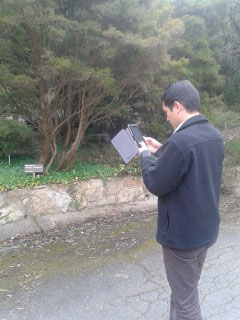AJ and I are just back from Canberra, where a recurring theme of the trip was about bar codes, and specifically about QR codes.
 While we were in Canberra on Monday, we had a little bit of time to go for a wander around the Australian National Botanic Gardens, where we decided to do some more testing of the mobile side of the citizen science software we are developing for the Atlas of Living Australia. So as we were wandering around, we started talking about bar code scanning, which is one of the new enhancements we’ve just put in place for these tools.
While we were in Canberra on Monday, we had a little bit of time to go for a wander around the Australian National Botanic Gardens, where we decided to do some more testing of the mobile side of the citizen science software we are developing for the Atlas of Living Australia. So as we were wandering around, we started talking about bar code scanning, which is one of the new enhancements we’ve just put in place for these tools.
We were playing around with the mobile devices when one of the staff wandered past and asked us what we were up to, and we ended up having a discussion about the way in which QR codes could be used in collections and gardens. We then talked more about it with collections staff shortly afterwards. We were a litle surprised that people were looking at buying specialised equipment for creating and printing bar codes, because you can generate bar codes in a range of ways for free for testing and evaluation purposes.
One of the simplest ways to do this is to go to http://qrcode.kaywa.com/ and generate a QR code from there. You can paste in a URL, text block, phone number etc, and the site will generate you a QR Code in either small, medium or large size, and display it as an image. This is a non-commercial site, that is still in beta, but it is a really useful test bed for playing with the technology and seeing what it can do. There are also a few other ways to generate QR codes, using other software around the place.
Once you’ve got the image of a bar code, you can then download it and print it out. Then you can move onto the various different types of mobile applications that allow you to scan barcodes. As an example, you can find a listing of these on the Android Marketplace here or AppStore here. Once you have one installed, you can scan the bar code you created, and then click on the hyperlink you encoded in it, or see a value from the code.
We’ve integrated bar code scanning into our mobile citizen science application so that you can do things like scan a bar code at a photo station, or off a voucher specimen label, and the value from the scanned bar code gets stored. We’re also looking at a range of other ways to incorporate bar code scanning into other workflows and practices, and we’ll do another article on our results in the future. ‘Til then, have a play and let us know how you go!
Piers

Comments are closed.